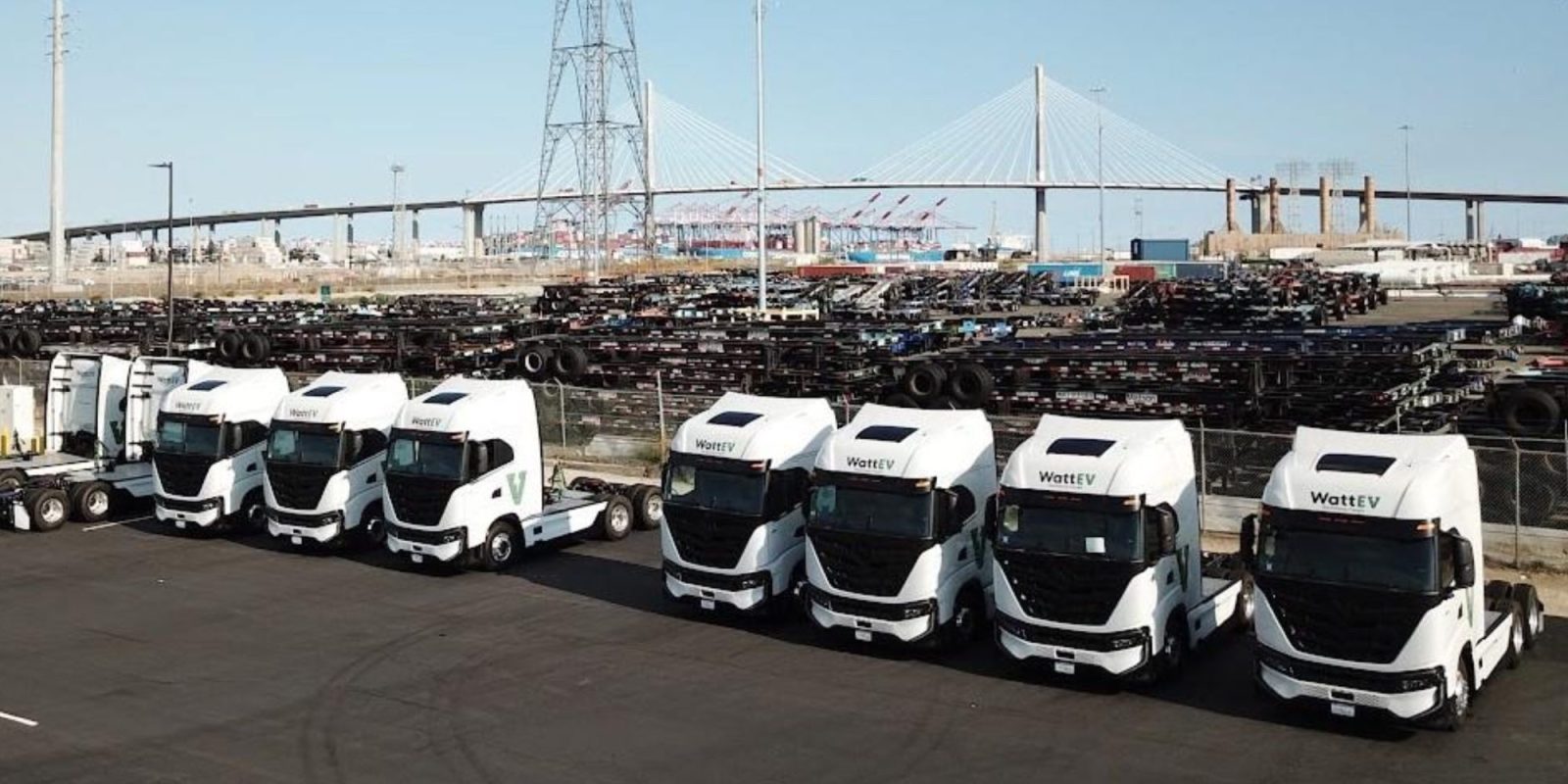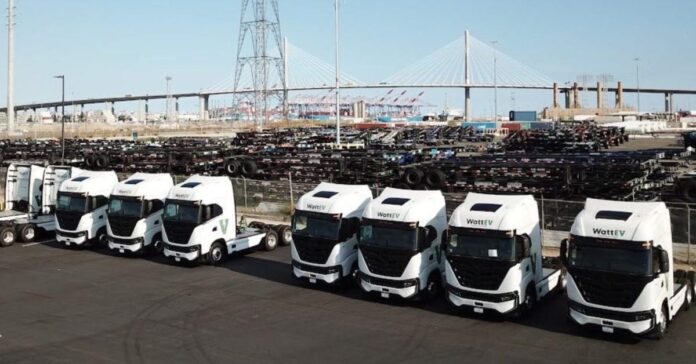[ad_1]

EPA’s Heavy Duty “Phase 3” truck rule has been finalized, and surprisingly enough it comes in stronger (albeit slightly) than the rule that was originally proposed last year.
The final rule has just come out, so there’s plenty to comb through, but the EPA went over some key points in a press call yesterday.
Transportation is the largest-polluting sector in America, and heavy duty vehicles make a disproportionate amount of that pollution. Light duty vehicles still produce the majority – about 60% of transportation emissions are from light-duty vehicles – but heavy duty vehicles are responsible for about a quarter of transportation emissions, despite only being 5% of vehicles.
This underlines the importance of regulating these vehicles, and the outsize gains that we can get from doing so.
New rule saves 1 billion tons CO2 and $13 billion/yr
The main numbers for the finalized rule are that it will save $13 billion per year in annualized net benefits for society, avoid a billion tons worth of greenhouse gas emissions, and reduce air pollution for the 72 million Americans who live within 200 meters of a heavy duty truck route (a group that is disproportionately from disadvantaged communities). The rules cover model years 2027-2032.
The cost and health savings make these rules a rare win-win-win. Businesses save money on costs (approx. $3.5b annually, between $3-10k per vehicle depending on type), health and environmental savings benefit everybody, and the industry gets nudged towards a future that it needs to accept anyway. Or, well… not that rare, considering most positive environmental moves offer these sorts of benefits.
Like the light-duty rules, the heavy-duty rules are “technology neutral,” in that they don’t mandate manufacturers use specific technologies, but rather meet certain pollution guidelines that will require significant improvements in engine technologies used. This means hybrid, plug-in hybrid, battery-electric and fuel cell vehicles are all on the table.
The rule actually got stronger for once
And the most remarkable thing about the rules is that they actually got (very slightly) stronger between the proposed and final rule, due to the 175,000 comments EPA said were left during the comment period.
EPA originally stated that the proposed rule would reduce carbon by 1.8 billion tons, but had to re-do the baseline of these calculations due to California’s strong truck rules, which will reduce overall emissions by a huge chunk (both in California and other states). Now, EPA says that the proposed rule would have reduced carbon by 998 million tons under the revised baseline, or 1 billion tons for the final rule. So, only improved by .2%, but still a tiny improvement, as opposed to going in the other direction.
This is not a common occurrence – we pointed out last week that the opposite happened with light-duty rules, and that this seems to be depressingly common lately. Whenever a new rule comes out, no matter how well-reasoned and attainable, industry lobbies for it to be loosened (and not just in the US, see: Europe, Australia), and usually compromises go their way, not the public’s way.
The changes between the proposed rule and the final one include a softening of the rules from 2027-2030 to give companies more time to arrange charging infrastructure, but also stronger emissions limits in 2031 and 2032 for most vehicle classes. For example, certain medium-heavy vocational vehicles will have 40% stronger limits in 2032 in the final rule as compared to Phase 2 regulation, rather than 35% in the proposed rule.
EPA didn’t break down every change between the proposed and final rule on the press call, because this rule covers so many different classes of vehicle. But overall, this is an improvement compared to the changes in the light duty rules – those only got weaker, whereas these got stronger, just with a little more flexibility in adoption timelines.
Broadly positive reaction to the heavy duty truck rule
Reaction has been broadly positive to the adoption of these phase 3 rules. The American Lung Association celebrated the rules, which along with the EPA’s previous NOx rule brings $22b in health savings per year, and pointed out the rarity of rules getting stronger during the rulemaking process. It also noted that Americans support strong truck regulations by extremely wide margins. Praise also came from the Sierra Club, the Hip Hop Council (who focused on the environmental justice aspect of these rules), and even from industry representatives.
Some industry sources did oppose these rules, or ask for them to be scaled back, such as various oil companies and some truck makers (for example Daimler Trucks and Volvo Trucks, both of which publicly supported the rule but privately called for its delay, despite being leaders in electrified trucks). But several large groups supported them.
In the runup to adoption of the rule, 100+ businesses called for a strong truck standard. This included a newly-formed industry group called the Heavy Duty Leadership Group, which called for rapid approval of a strong EPA rule, and each of its four participants – Ford, Cummins, BorgWarner and Eaton made statements praising the final rule that EPA adopted today. Even military leaders had good things to say about the new rule, through SAFE, an organization that advocates a break from oil from an energy and national security perspective.
How the Biden Administration has helped electrification from every angle
One strength of the rules is how comprehensive they are, especially when considering parallel regulations and incentives created by the administration. Many have pointed to individual EPA rules and stated that they are too narrow, or don’t properly acknowledge the full picture of how electrification would work. But when taken as a whole, the actions done by the EPA and the Biden administration cover almost every conceivable angle of the electrification of transportation.
This rule regulates truck carbon emissions, but another rule regulated smog-forming emissions, and another one regulated railroads, and we still have one coming to increase fleet mpg requirements (building on a change in EV mpg calculations so manufacturers can’t just build a few compliance EVs).
To take care of upfront costs, the Inflation Reduction Act includes commercial credits for both ZEV truck purchases and charger installations (and domestic production provisions and incentives, too). The Bipartisan Infrastructure Law incentivizes chargers further. Ports get specific support from the Clean Ports Program, as do school buses, and the EPA is ensuring that California will remain a testbed for even better environmental rules. The administration also recently released a master infrastructure plan to electrifying all the US’ freight routes by 2040.
So… that takes care of just about everything, right?
Electrek’s Take
As we always say, we’d never mind stronger rules than those that get implemented. We need to electrify transportation, and soon, and we simply aren’t doing enough to fight climate change.
But despite my constant “why not sooner?” headlines, I have been particularly impressed by recent truck regulations in this country (both California’s and this new EPA rule). I also think the EPA’s light-duty rule is exceedingly well-reasoned and works towards fixing some huge problems (like vehicle size), though the original proposal was better.
And that’s the most impressive part about this rule. I lamented in the Take for the light-duty rule that regulations seem to always get compromised in favor of polluters, never in favor of the public interest. But this time, that didn’t happen – it’s a compromise, and the polluters did get a little bit of what they wanted, but the public also got even better final regulations than we originally were going to get, and it balanced out to a very slightly better rule in the end.
Like the Lung Association said (understatedly): “this does not always happen.” And yet, today, it did.
We can all be glad for that – and the 72 million Americans who live within 200 meters of a truck route, especially, will get to breathe a lot more cleanly in the coming years.
FTC: We use income earning auto affiliate links. More.
[ad_2]
Source link















